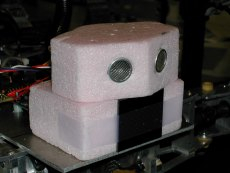Whegs™ II is an improvement over Whegs™ I in terms of durability and capability. In addition to a more advanced wheg design, it has a body joint that allows it to climb over taller obstacles. The goals of the Whegs™ II robot are to develop a more capable, robust platform inspired by cockroach locomotion. Based on these principles Whegs™ II is able to traverse varying, difficult terrain and can employ a variety of sensors allowing it to mimic cockroach behavior.
With the addition of sensors, low-computational power microcontrollers, and basic insect-like behaviors Whegs™ II is able to autonomously navigate its environment.
After analyzing how a cockroach positions its antennae when deciding to climb over or tunnel under a shelf-like obstacle, mechanical antennae were designed and fitted to Whegs™ II. The mechanical antennae sweep up and down, each at a different rate, as the robot moves through its environment. When a shelf is encountered, the position of the antennae on the obstacle helps Whegs™ II autonomously decide whether to climb or tunnel.
For environments without shelf-like obstacles a new sensor and behavior system has been developed. This system uses ultrasonic range finding sensors to detect obstacles. It uses a single emitter and a pair of splayed receivers to detect obstacles left, right, and in front of Whegs™ II.
Using interaural time differences (ITD), Whegs™ II is able to specifically locate the position of obstacles in a similar manner as owls and people. This behavior measures the time it takes for an ultrasonic echo to reach the left and right receivers and uses triangulation to pinpoint the obstacle’s position.
The position of the obstacle from the current heading (left or right of center-line) determine steering and the distance from the front of the robot determine speed. All of the obstacle position sensing, speed, and steering is autonomously generated by Whegs™ II without any operator intervention.
The research and design improvements of Whegs™ II led to the development of DAGSI Whegs™










